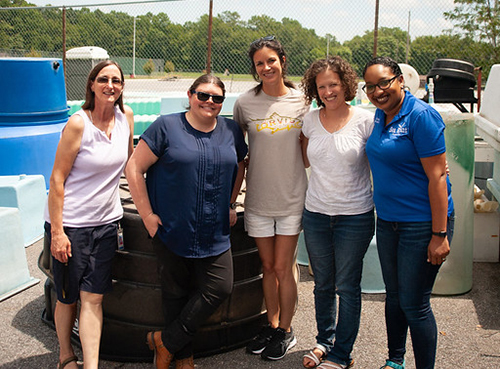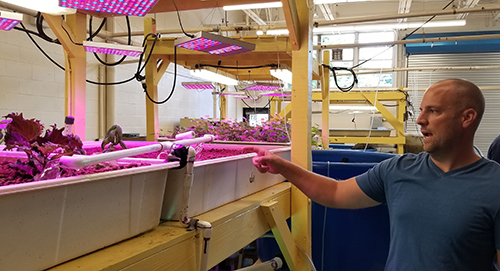In Wisconsin, the word “farming” may first call to mind images of dairy cows or cornfields. But across the globe, the fastest growing segment of agriculture is aquaculture.
As the Food and Agriculture Organization of the United Nations states on its website, aquaculture “now accounts for nearly 50 percent of the world’s food fish.”
As a result of this growth, career opportunities for students with aquaculture training are abundant. The industry’s rise also makes it highly relevant for K-12 teachers seeking to incorporate hands-on science learning in their classrooms.
Aquaculture Outreach Specialist Emma Wiermaa is enthusiastic about the educational and professional opportunities surrounding the field. The University of Wisconsin-Stevens Point Northern Aquaculture Demonstration Facility (UWSP NADF), based in Bayfield, and Wisconsin Sea Grant jointly fund her efforts.

Emma Wiermaa (center) with fellow educators at the Sea Grant Aquaculture Education Network Summit in Maryland. (Photo: Nicole Lehming, Maryland Sea Grant)
Aquaculture education is a major component of Wiermaa’s work. To connect with others eager to advance K-12 students’ learning about the subject, she traveled to Maryland in July to attend the Sea Grant Aquaculture Education Network Summit.
This was the first summit of its kind, attracting participants from places as far-flung as California, Maine and Puerto Rico. Funding and support from the National Marine Sanctuaries Foundation and the NOAA Office of Education made the three-and-a-half day event possible.
Said Wiermaa, “It was so impactful to meet all these educators who share the same mission to promote STEM (science, technology, engineering and math) concepts through aquaculture. Teachers—especially agriculture teachers—get excited about it, and students love the hands-on learning.”
Participants learned about an innovative curriculum used in rural Carroll County, Maryland, where Maryland Sea Grant has partnered with schools since the mid-1990s. Schools there use an “aquaculture in action” model centered on project-based learning.
Summit attendees also toured the Institute of Marine & Environmental Technology, a leader in sustainable aquaculture research with a focus on land-based, recirculating aquaculture systems.
Building a workforce ready for career opportunities
In addition to teaching important scientific concepts, workforce development is another reason to introduce aquaculture principles in K-12 settings, said Wiermaa.
“Career opportunities in aquaculture are immense right now,” she said. Students with an interest in fish biology and fisheries may not know about aquaculture jobs, gravitating instead to roles that are more visible or familiar, such as in state management agencies or the U.S. Fish & Wildlife Service. “We can help these students learn about opportunities they never even knew existed.”
Explained Wiermaa, “NADF has worked with schools since the facility started,” interacting with K-12 educators and students across Wisconsin. UWSP NADF’s support includes classroom visits, technical assistance with aquaculture systems, and showing real-world applications during interactive tours of the facility.

A Maryland teacher shows summit participants a classroom aquaponic system. (Photo: Emma Wiermaa)
Additionally, UWSP NADF donates surplus fish left over from research studies to schools for use in classroom aquaculture systems.
The business community and Wisconsin’s economy stand to benefit from enhanced aquaculture education, too, Wiermaa said.
“A limiting factor for a lot of businesses starting up is that there are not a lot of graduates out there with significant experience behind them, especially for management roles. These aquaculture businesses need an experienced workforce” to thrive, she noted.
UW-Stevens Point is at the forefront of aquaculture and aquaponics in higher education. The campus was first in the state to offer an aquaculture minor and first in the nation to offer full-semester aquaponics courses and a professional aquaponics certificate.
Stevens Point graduate Brandon Gottsacker is president of Wisconsin-based Superior Fresh, located in Hixton, which is the world’s largest aquaponics facility.
Gottsacker can attest to the need for skilled employees: “Aquaculture and aquaponic systems are extremely complex, and they require qualified staff to operate the systems effectively. Unfortunately, there are very few trained or experienced people available to the industry today, forcing Superior Fresh and similar companies to spend a lot of energy training people in-house.”
Growing an educational network
Wiermaa is eager to expand aquaculture education efforts, particularly as part of the broad, national network fostered by the Sea Grant summit.
“This is a nationwide effort across Sea Grant states, and it is exciting to be part of it,” said Wiermaa.
While there are some teacher guides available, Wisconsin does not yet have a state standard curriculum for aquaculture. The summit held in Maryland exposed Wiermaa to different curricular formats, and the varying backgrounds of attendees enriched the experience.
Wiermaa’s next steps include continuing to work with colleagues she met in Maryland to build a network of collaborators. She also wants to reach out even more widely to Wisconsin educators to let them know that Wisconsin Sea Grant and UWSP NADF are a resource they can call upon in order to teach aquaculture concepts in the classroom.
She hopes educators will consider attending the next conference of the Wisconsin Aquaculture Association, to be held March 5-7, 2020, in Marshfield. Planning is underway to have an aquaculture education session specifically for teachers at the conference.
From teachers to fish farmers, said Wiermaa, there is a lot of support for aquaculture in the classroom and the development of robust, hands-on curricular materials. It’s a win-win, she noted: “Everybody wants this to happen because it’s both STEM education and workforce development.”
To learn more, contact Wiermaa at ewiermaa@uwsp.edu or visit aquaculture.uwsp.edu.
To view photos from the Sea Grant Aquaculture Education Network Summit, browse Maryland Sea Grant’s Flickr album. You can also watch a Maryland Sea Grant video on YouTube about the “Aquaculture in Education” program.





